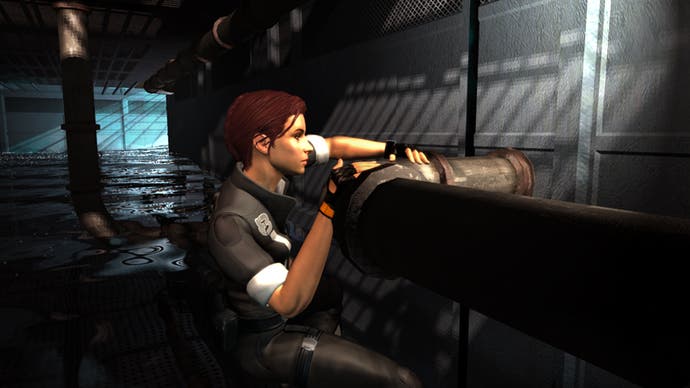Hydrophobia
Swept away with Blade's kingdom by the sea.
The real star of Hydrophobia isn't female lead Kate, but the water that rapidly floods the environments and influences almost every aspect of gameplay. This isn't about pretty water reflections that merely slow a characters' movement, nor is it about taking games back to that period where every adventure game had to have an underwater level, just because it could. The water in Hydrophobia is more than that - it acts as a weapon, a key, transportation and an entire control system that the player uses to influence, change and conquer the environment.
The environment itself is a massive floating city named the Queen of the World, something that developer Blade Interactive has based on real-world designs such as The Freedom Ship. It's not just the environment that Blade wants to be fantastic yet plausible - elements of the storyline and the science behind it are intended to contain real-world elements that blur the line between science and science fiction. The Queen of the World is a haven for the world's super-rich elite, containing everything you'd expect to find in wealthy cultures - from apartments and casinos to retail outlets and corporate businesses. And as well as the socialites occupying the upper decks and towers, there are also the lowly workers confined to the bowels of the ship, serving the parasitic occupants and pandering to their spoilt needs.
Sea Change
The beautiful people have been attracted to the Queen of the World because it's a private society with no prying eyes. But this makes it the perfect target for terrorism, with a group named the Malthusian's infiltrating the Queen before it's even begun its maiden voyage. Again using real-world elements, the insurgents ideals are based on Thomas Malthus - a political economist whose work influenced Charles Darwin and Karl Marx - and centre around issues of climate change and population growth. It's certainly a refreshing change from the usual ethnic stereotypes that run around game worlds. At the beginning of the game The Malthusian's take over the Queen of the World leaving the player to adopt the role of Kate, a reluctant engineer charged with foiling the terrorist's schemes.

Story is one of the key elements to Hydrophobia, with Blade taking it just as seriously as the water physics, gameplay and graphics. The intention is to reveal story though interaction rather than stopping the drama to play a five minute cutscene, and there are also playable flashbacks that reveal just why a hydrophobic lead character is working on a floating city.
Kate's phobia is an element of gameplay that influences character control. When water begins to overpower Kate, the screen blurs and turns monochrome, audio becomes muffled and the players' field of vision warps. It's not as overwhelming as the effect used in Headfirst's Call of Cthulhu: Dark Corners of the Earth, but it's similar. Over time and through gameplay, Kate begins to master her fear, with the game changing and replacing the mechanic with something completely different, to be revealed at a later date.




.png?width=291&height=164&fit=crop&quality=80&format=jpg&auto=webp)



